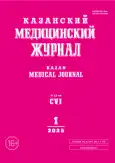Вейпинг-ассоциированные механизмы развития гастроэзофагеальной рефлюксной болезни
- Авторы: Шкляев А.Е.1, Дударев В.М.1, Пантюхина А.С.1, Галиханова Ю.И.1
-
Учреждения:
- Ижевская государственная медицинская академия
- Выпуск: Том 106, № 1 (2025)
- Страницы: 35-41
- Тип: Теоретическая и клиническая медицина
- URL: https://journal-vniispk.ru/kazanmedj/article/view/286123
- DOI: https://doi.org/10.17816/KMJ636950
- ID: 286123
Цитировать
Аннотация
Актуальность. Имеются убедительные доказательства негативного влиянии вейпинга на состояние дыхательной и сердечно-сосудистой систем. Кроме того, целесообразна оценка гастроэнтерологических аспектов курения электронных сигарет.
Цель. Оценить влияние вейпинга на функциональное состояние гастроэзофагеальной зоны у здоровых людей по сравнению с пациентами, страдающими гастроэзофагеальной рефлюксной болезнью.
Материал и методы. В исследование включены 90 пациентов, которые разделены на три группы по 30 человек. Первую группу составили лица без заболеваний желудочно-кишечного тракта, регулярно (более 12 мес) курящие вейпы. Пациенты 2-й группы страдали гастроэзофагеальной рефлюксной болезнью. В 3-ю группу (контрольную) вошли здоровые лица без вредных привычек. С помощью валидизированных опросников оценивали клинические проявления рефлюкс-синдрома, выполняли суточную рН-импедансометрию, исследование сывороточных уровней гастрина и мотилина. Статистическую обработку проводили с использованием критерия Краскела–Уоллиса и теста Данна. Для сравнения качественных признаков применяли точный критерий Фишера, для оценки зависимостей — коэффициент корреляции Спирмена. В исследовании установлен критерий значимости р <0,05.
Результаты. Во 2-й группе, наряду с симптомами рефлюксной болезни, зарегистрировали низкий уровень pH нижней трети пищевода, высокое суточное число всех типов рефлюксов. В данной группе, в сравнении с контрольной, выявили низкий уровень мотилина в крови (83,2 [56,9; 99,3] пг/мл и 189,7 [117,6; 362,3] пг/мл соответственно, p=0,001).
В группе вейперов, в сравнении со здоровыми, зафиксировали большую выраженность рефлюкс-синдрома и увеличение суточного количества кислых (54 [39,5; 71] и 21,5 [18; 28,8] соответственно, p=0,001) и слабокислых (7,5 [4,3; 9,8] и 2 [1; 3] соответственно, p=0,001) рефлюксов, на фоне снижения уровня рН в пищеводе (4,7 [4,1; 5,9] и 6,7 [6,2; 6,8] соответственно, p=0,001).
Заключение. Вейпинг сопровождается увеличением числа гастроэзофагеальных рефлюксов, вероятно, вследствие угнетения моторики нижнего пищеводного сфинктера и может способствовать развитию гастроэзофагеальной рефлюксной болезни.
Ключевые слова
Полный текст
Открыть статью на сайте журналаОб авторах
Алексей Евгеньевич Шкляев
Ижевская государственная медицинская академия
Email: shklyaevaleksey@gmail.com
ORCID iD: 0000-0003-2281-1333
SPIN-код: 3537-8929
д-р мед. наук, проф., каф. факультетской терапии с курсами эндокринологии и гематологии
Россия, 426056, Ижевск, улица Коммунаров, д. 281Валерий Михайлович Дударев
Ижевская государственная медицинская академия
Автор, ответственный за переписку.
Email: izhstalfanat@mail.ru
ORCID iD: 0000-0002-5840-461X
SPIN-код: 4125-1073
асс., каф. факультетской терапии с курсами эндокринологии и гематологии
Россия, 426056, Ижевск, улица Коммунаров, д. 281Ангелина Сергеевна Пантюхина
Ижевская государственная медицинская академия
Email: pantyukhina1985@yandex.ru
ORCID iD: 0009-0004-3352-0907
SPIN-код: 1547-1776
канд. мед. наук, асс., каф. факультетской терапии с курсами эндокринологии и гематологии
Россия, 426056, Ижевск, улица Коммунаров, д. 281Юлия Ивановна Галиханова
Ижевская государственная медицинская академия
Email: galihanova_julia@mail.ru
ORCID iD: 0000-0003-0005-4925
SPIN-код: 9837-6638
асп., каф. факультетской терапии с курсами эндокринологии и гематологии
Россия, 426056, Ижевск, улица Коммунаров, д. 281Список литературы
- Подзолков В.И., Ветлужская М.В., Абрамова А.А., и др. Вейпинг и вейп-ассоцированное поражение легких // Терапевтический архив. 2023. Т. 95, № 7. С. 591–596. doi: 10.26442/00403660.2023.07.202293
- Макарова И.А., Акатова Е.В., Николин О.П., Иванова О.С. Вейпинг – вредная привычка или субкультура // Наркология. 2024. Т. 23, № 2. С. 60–78. doi: 10.25557/1682-8313.2024.02.60-78
- Savitz DA. Invited commentary: the epidemiology of electronic cigarettes and reproductive health begins // Am J Epidemiol. 2021. Vol. 190, N. 3. P. 362–364. doi: 10.1093/aje/kwaa066
- Li X., Yuan L., Wang F. Health outcomes of electronic cigarettes // Chin Med J. 2024. Vol. 137, N. 16. P. 1903–1911. doi: 10.1097/CM9.0000000000003098
- Skotsimara G., Antonopoulos A.S., Oikonomou E., et al. Cardiovascular effects of electronic cigarettes: A systematic review and meta-analysis // Eur J Prev Cardiol. 2019. Vol. 26, N. 11. P. 1219–1228. doi: 10.1177/2047487319832975
- Lyzwinski L.N., Naslund J.A., Miller C.J., Eisenberg M.J. Global youth vaping and respiratory health: epidemiology, interventions, and policies // NPJ Prim Care Respir Med. 2022. Vol. 32, N. 1. P. 14. doi: 10.1038/s41533-022-00277-9
- Pasricha T.S., Kochar B. Vaping-associated esophagitis // BMC Gastroenterol. 2021. Vol. 21, N. 1. P. 106. doi: 10.1186/s12876-021-01695-8
- Yan Z., Xu Y., Li K., Liu L. Genetic correlation between smoking behavior and gastroesophageal reflux disease: insights from integrative multi-omics data // BMC Genomics. 2024. Vol. 25, N. 1. P. 642. doi: 10.1186/s12864-024-10536-3
- Runge T.M., Abrams J.A., Shaheen N.J. Epidemiology of Barrett's Esophagus and Esophageal Adenocarcinoma // Gastroenterol Clin North Am. 2015. Vol. 44, N. 2. P. 203–231. doi: 10.1016/j.gtc.2015.02.001
- Ивашкин В.Т., Маев И.В., Трухманов А.С., и др. Рекомендации Российской гастроэнтерологической ассоциации по диагностике и лечению гастроэзофагеальной рефлюксной болезни // Российский журнал гастроэнтерологии, гепатологии, колопроктологии. 2020. Т. 30, № 4. С. 70–97. doi: 10.22416/1382-4376-2020-30-4-70-97
- Ивашкин В.Т., Маев И.В., Трухманов А.С., Румянцева Д.Е. Современные достижения в диагностике и лечении рефрактерной формы гастроэзофагеальной рефлюксной болезни // Терапевтический архив. 2018. Т. 90, № 8. С. 4–12. EDN: XVYHEL doi: 10.26442/terarkh20189084-12
- Кайбышева В.О., Кучерявый Ю.А., Трухманов А.С., и др. Результаты многоцентрового наблюдательного исследования по применению международного опросника GerdQ для диагностики гастроэзофагеальной рефлюксной болезни // Российский журнал гастроэнтерологии, гепатологии, колопроктологии. 2013. Т. 23, № 5. С. 15–23. EDN: RFLZYR
- Gyawali C.P., Yadlapati R., Fass R., et al. Updates to the modern diagnosis of GERD: Lyon consensus 2.0 // Gut. 2024. Vol. 73, N. 2. P. 361–371. doi: 10.1136/gutjnl-2023-330616
- Braverman A.S., Vegesna A.K., Miller L.S., et al. Pharmacologic specificity of nicotinic receptor-mediated relaxation of muscarinic receptor precontracted human gastric clasp and sling muscle fibers within the gastroesophageal junction // J Pharmacol Exp Ther. 2011. Vol. 338, N. 1. P. 37–46. doi: 10.1124/jpet.110.177097
- Mori H., Verbeure W., Tanemoto R., et al. Physiological functions and potential clinical applications of motilin // Peptides. 2023. Vol. 160. P. 170905. doi: 10.1016/j.peptides.2022.170905
- Кузнецова Е.И., Рымарева Е.А., Дичева Д.Т., Андреев Д.Н. Гастроэзофагеальная рефлюксная болезнь и сахарный диабет: патофизиологические механизмы коморбидности // Consilium Medicum. 2019. Т. 21, № 8. С. 23–28. doi: 10.26442/20751753.2019.8.190497
- Шкляев А.Е., Шутова А.А., Казарин Д.Д., и др. Влияние концентрации мотилина в крови на клиническую симптоматику функциональной диспепсии // Экспериментальная и клиническая гастроэнтерология. 2022. № 9. С. 58–64. doi: 10.31146/1682-8658-ecg-205-9-58-64
Дополнительные файлы






